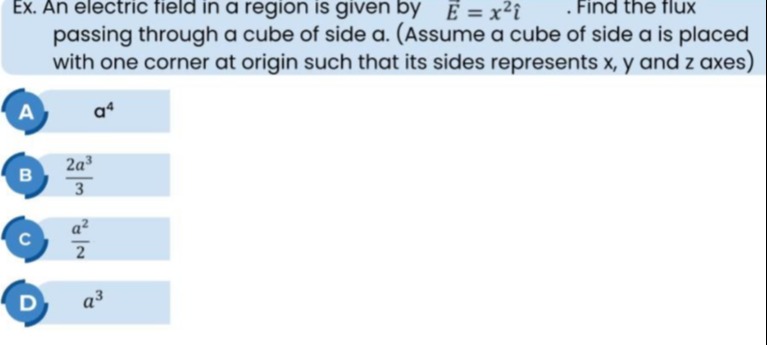Question
Question: Ex. An electric field in a region is given by $\overrightarrow{E} = x^2\hat{i}$. Find the flux passi...
Ex. An electric field in a region is given by E=x2i^. Find the flux passing through a cube of side a. (Assume a cube of side a is placed with one corner at origin such that its sides represents x, y and z axes)

a4
32a3
2a2
a3
A
Solution
The electric field in the region is given by E=x2i^. The cube of side 'a' is placed with one corner at the origin, and its sides are along the x, y, and z axes. The cube is bounded by the planes x=0, x=a, y=0, y=a, z=0, z=a. The electric flux through a closed surface is given by Φ=∮E⋅dA. We need to calculate the flux through each of the six faces of the cube and sum them up.
-
Face at x=0: This face is in the yz-plane at x=0. The area vector is dA=dA(−i^). At this face, x=0, so the electric field is E(x=0)=(0)2i^=0. The flux through this face is Φ1=∫E(x=0)⋅dA=∫0⋅dA=0.
-
Face at x=a: This face is a square in the plane x=a. The area vector is dA=dA(+i^). At this face, x=a, so the electric field is E(x=a)=a2i^. The flux through this face is Φ2=∫E(x=a)⋅dA=∫(a2i^)⋅(dAi^)=∫a2dA. Since the face is a square of side 'a', its area is A=a2. Φ2=a2∫dA=a2(a2)=a4.
-
Face at y=0: This face is in the xz-plane at y=0. The area vector is dA=dA(−j^). The electric field is E=x2i^. The flux through this face is Φ3=∫E⋅dA=∫(x2i^)⋅(dA(−j^))=0, since i^⋅j^=0.
-
Face at y=a: This face is in the xz-plane at y=a. The area vector is dA=dA(+j^). The electric field is E=x2i^. The flux through this face is Φ4=∫E⋅dA=∫(x2i^)⋅(dA(+j^))=0, since i^⋅j^=0.
-
Face at z=0: This face is in the xy-plane at z=0. The area vector is dA=dA(−k^). The electric field is E=x2i^. The flux through this face is Φ5=∫E⋅dA=∫(x2i^)⋅(dA(−k^))=0, since i^⋅k^=0.
-
Face at z=a: This face is in the xy-plane at z=a. The area vector is dA=dA(+k^). The electric field is E=x2i^. The flux through this face is Φ6=∫E⋅dA=∫(x2i^)⋅(dA(+k^))=0, since i^⋅k^=0.
The total flux passing through the cube is the sum of the fluxes through all six faces: Φtotal=Φ1+Φ2+Φ3+Φ4+Φ5+Φ6=0+a4+0+0+0+0=a4.
The final answer is a4.
Explanation of the solution: The electric field is E=x2i^. The cube is from x=0 to a, y=0 to a, z=0 to a. Flux through the face at x=0: E=0, so flux = 0. Flux through the face at x=a: E=a2i^. Area vector is a2i^. Flux = (a2i^)⋅(a2i^)=a4. Flux through faces perpendicular to y and z axes: E is in i^ direction, area vectors are in j^ or k^ directions. Dot product is zero, so flux = 0 for these four faces. Total flux = 0+a4+0+0+0+0=a4.
